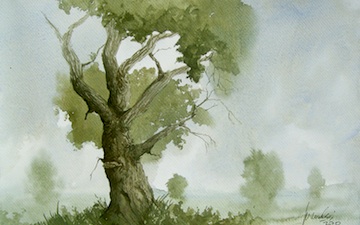Quercus robur (synonym Q. pedunculata) is commonly known as the English oak orpedunculate oak or French oak. It is native to most of Europe, and to Anatolia to the Caucasus, and also to parts of North Africa.
Quercus robur is a large deciduous tree, with circumference of grand oaks from 4 m (13′) to exceptional 12m (40′).[citation needed] Majesty Oak with the circumference of 12,2 m (40′) is the thickest tree inGreat Britain,[citation needed] but Kaive Oak in Latviawith the circumference of 10,2 m (33,5′) is the thickest tree in Northern Europe.[citation needed] Q. robur has lobed and nearly sessile (very short-stalked) leaves 7–14 cm long. Flowering takes place in mid spring, and their fruit, called acorns, ripen by the following autumn. The acorns are 2–2.5 cm long, pedunculate (having a peduncle or acorn-stalk, 3–7 cm long) with one to four acorns on each peduncle.
It is a long-lived tree, with a large widespreading crown of rugged branches. While it may naturally live to an age of a few centuries, many of the oldest trees are pollarded or coppiced, both pruning techniques that extend the tree’s potential lifespan, if not its health. Two individuals of notable longevity are the Stelmužė Oak in Lithuania and the Granit oak in Bulgaria, which are believed to be more than 1,500 years old, possibly making them the oldest oaks in Europe; another specimen, called the ‘Kongeegen’ (‘Kings Oak’), estimated to be about 1,200 years old, grows in Jaegerspris, Denmark.[citation needed] Yet another can be found in Kvilleken, Sweden, that is over 1,000 years old and 14 metres around.[1] Of maiden (not pollarded) specimens, one of the oldest is the great oak of Ivenack, Germany. Tree-ring research of this tree and other oaks nearby gives an estimated age of 700 to 800 years old. Also the Bowthorpe Oak in Lincolnshire, England is estimated to be 1,000 years old making it the oldest in the UK, although there is Knightwood Oak in theNew Forest which is also said to be as old. Highest density of the Q. robur grand oaks with a circumference 4 metres and more is in Latvia.[citation needed]
Within its native range Q. robur is valued for its importance toinsects and other wildlife. Numerous insects live on the leaves, buds, and in the acorns. Q.robur supports the highest biodiversity of insect herbivores of any British plant (>400 spp). The acorns form a valuable food resource for several small mammals and some birds, notably Eurasian JaysGarrulus glandarius. Jays were overwhelmingly the primary propagators[2] of oaks before humans began planting them commercially, because of their habit of taking acorns from the umbra of its parent tree and burying it undamaged elsewhere. Mammals, notably squirrels who tend to hoard acorns and other nuts most often leave them too abused to grow in the action of moving or storing them.
(Via Wikipedia, October, 2012)





